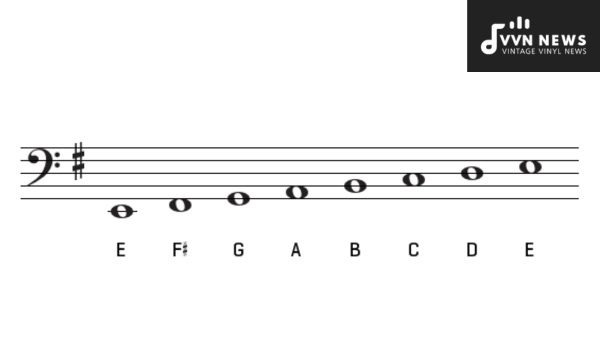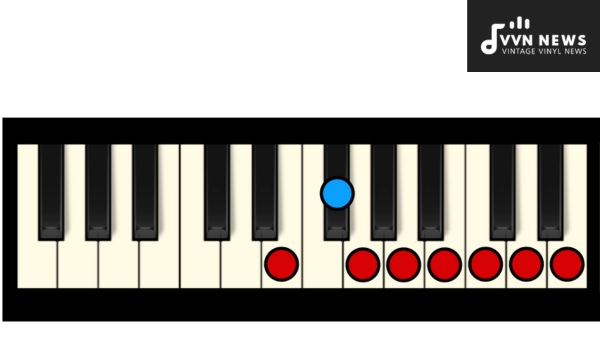The E Minor Chords is crucial for any aspiring guitarist or music enthusiast.
Whether you are a beginner just starting to learn the basics of playing the guitar or a seasoned musician looking to broaden your chord vocabulary, the E minor chord is a versatile and essential component of any guitarist’s repertoire.
I will delve into the fundamentals of the E minor chord, its construction, and its various applications in different musical genres.
When it comes to playing chords on the guitar, the E minor chord is one of the most commonly used and recognized.
It has a haunting and melancholic sound that adds depth and emotion to any piece of music. The E minor chord consists of three notes: E, G, and B.
These notes are derived from the natural minor scale in which the root note is E.
To play the E minor chord on the guitar, press down your second finger on the second fret of the A string, your third finger on the second fret of the D string, and leave all other strings open.
This simple finger positioning allows you to strum all six strings of the guitar while creating a rich and resonant sound.
What Are the Basic Chords in E Minor?
In the key of E minor, four basic chords are commonly used: E minor (Em), G major (G), A minor (Am), and B diminished (Bdim). These chords form the foundation for many songs and compositions in this key. Let’s take a closer look at each of these chords:
- E minor (Em): This is the tonic chord and the most important chord in the key of E minor. It is a triad consisting of E, G, and B notes. The simplest way to play this chord on the guitar is by pressing down your second finger on the second fret of the A string and strumming all six strings.
- G major (G): This chord adds brightness and contrast to compositions in E minor. It is a triad made up of G, B, and D notes. To play this chord on the guitar, place your third finger on the third fret of the low E string and your second finger on the second fret of the A string.
- A minor (Am): Another crucial chord in E minor is A minor, which brings a sense of resolution and stability to compositions. It consists of A, C, and E notes. To play this chord on the guitar, press down your first finger on the first fret of the B string.
- B diminished (Bdim): This chord provides tension and can be used to transition smoothly to other chords within a song in E minor. It is formed by combining B, D, and F notes. To play Bdim on guitar, barre all strings at the second fret with your first finger.
By mastering these basic chords in E minor, you will have a solid foundation to start exploring more complex chord progressions and creating beautiful music in this key.
Also Read: D Minor Pentatonic Scale [Make Your Music Sing With Emotion]
How to Apply Chord Theory to Compose in E Minor?
When it comes to composing music in E minor, understanding chord theory can greatly enhance your ability to create interesting and captivating compositions. Here are some key steps to help you apply chord theory effectively:
1. Determine the Key:
Before you start composing, it is essential to establish that your composition will be in the key of E minor. This means that the root note and tonal center of your composition will be E.
2. Constructing chords:
Understanding how chords are constructed within a given key is vital. In the key of E minor, you can use the natural minor scale (E, F#, G, A, B, C, D) as a reference. By taking specific notes from this scale, you can build various chords.
3. Building triads:
Triads are three-note chords comprising a root note, a third interval (either major or minor), and a fifth interval. In E minor, for example, the triad would consist of three notes: E (root), G (minor third), and B (fifth).
4. Experiment with chord progressions:
Chord progressions are sequences of chords that create harmonic movement within a composition. In E minor, common chord progressions include Em-G-D-Am or Em-C-D-G. Experiment with different progressions until you find combinations that evoke the desired emotions and atmosphere.
5. Explore extensions and variations:
Once you have mastered basic triads and progressions in E minor, consider incorporating chord extensions and variations for added depth and complexity. These can include seventh chords like Em7 or dominant seventh chords like D7.
6. Use inversions for smooth transitions:
Chord inversions involve rearranging the order of the notes within a triad or extended chord while maintaining its tonality. Inversions can create smoother transitions between chords by minimizing large jumps in voicing.
By applying chord theory to compose in E minor, you can create compelling and harmonically-rich compositions. Experiment with different chords, progressions, and variations to develop your unique musical style within this key. Remember to trust your ears and let your creativity guide you as you explore the possibilities of chord theory in E minor composition.
Also Read: B Flat Minor Pentatonic Scale [Create Emotive Music In Minutes]
What Are the Unique Characteristics of E Minor Chords?

E minor chords have a unique set of characteristics that distinguish them from other chords. These characteristics contribute to the emotional and expressive qualities found in music composed in the key of E minor. Let’s delve deeper into these unique features:
1. Natural Minor Scale:
E minor is the relative minor of G major, which means both keys share the same key signature (one sharp). The natural minor scale in E consists of the notes E, F♯, G, A, B, C, and D. The chords derived from this scale form the foundation of E minor compositions.
2. Dark and Melancholic Sound:
The E minor chord is known for its somber and emotive quality. It evokes feelings of sadness, introspection, and longing. Due to its placement in the natural minor scale, with its flattened third (G) compared to the major chord’s major third (G♯), it creates a darker tonality.
3. Easy Transitioning:
E minor chords harmonize well with other chords in keys such as G major and C major. This makes it easy to create seamless progressions that flow naturally between different chords while maintaining a cohesive sound.
4. Versatility across Genres:
The versatility of E minor allows it to be used across various musical genres such as rock, pop, blues, folk, and classical music. From power ballads to soulful acoustic melodies, E minor adds depth and complexity to compositions.
5. Emotional Expression:
E minor chords are commonly used to convey emotions such as sadness, introspection, mystery, and nostalgia in musical compositions. They are often employed during poignant moments in songs to evoke an emotional response from listeners.
Understanding the unique characteristics of E minor chords enables musicians and composers to harness their expressive power effectively. Incorporating E minor chords into your compositions allows you to create captivating and emotional musical experiences.
Also Read: A Sharp Minor Pentatonic Scale [Unique Harmonic Possibilities]
How Do You Build Seventh Chords in E Minor?
Seventh chords add richness and complexity to music. In the key of E minor, there are three main types of seventh chords that can be built: E minor 7 (Em7), G major 7 (Gmaj7), and B minor 7 flat five (Bm7b5). Let’s take a look at how each of these seventh chords is constructed.
E minor 7 (Em7):
The Em7 chord is built by adding a flattened 7th note to the E minor triad. Here’s the step-by-step process to construct an Em7 chord:
- Start with the E minor triad: E, G, and B.
- Add the flattened 7th note, which is D.
- The final notes that make up an Em7 chord are: E, G, B, and D.
G major 7 (Gmaj7):
To build a Gmaj7 chord in the key of E minor, follow these steps:
- Begin with the G major triad: G, B, and D.
- Add the major 7th note, which is F#.
- The resulting notes for a Gmaj7 chord are: G, B, D, and F#.
B minor 7 flat five (Bm7b5):
Here’s how to construct a Bm+5 chord in the key of E minor:
- Start with the B diminished triad: B, D, and F.
- Add the flattened 7th note for this chord type, which is A.
- The notes that make up a Bm+5 chord are: B, D, F, and A.
By understanding how these seventh chords are built in the key of E minor and practicing their fingerings on your instrument of choice, you can add depth and sophistication to your music compositions.
Common Chord Progressions in E Minor

Chord progressions are essential elements in creating melodies and harmonies that evoke specific emotions in music. In the key of E minor, several chord progressions are commonly used across various musical genres. These progressions provide a solid structural framework for songwriting and improvisation. Here are some common chord progressions in E minor:
- Em – G – D – Em: This progression, known as the “E minor rock progression,” is frequently used in rock and pop music. It starts with the E minor chord, transitions to G, then D, before returning to Em.
- Em – Am – C – Em: Known as the “E minor folk progression,” this sequence is often found in folk and acoustic songs. It begins with the E minor chord, followed by A minor, C major, and resolves back to Em.
- Em – B7 – Am: This progression is popular in blues music and adds a touch of tension and release. It starts with Em, moves to B7 (dominant seventh), and resolves to Am.
- Em – C – G – D: Commonly used in pop and country genres, this sequence gives a bright and uplifting feel to compositions. It begins with Em, moves to C major, then G major, and finally resolves to D major.
- Am – Dm – G – Em: Referred to as the “E minor ballad progression,” this sequence creates a melancholic and emotional atmosphere. It starts with A minor, transitions to D minor, then G major before resolving back to E minor.
Also Read: A Flat Minor Pentatonic Scale [Unleash Subtle Tension In Your Music]
How Can Ear Training Improve Your E Minor Chord Mastery?
Ear training is an essential skill for any musician, and it can greatly improve your mastery of E minor chords. When you develop your ear, you train yourself to recognize and identify different chords by their sound alone. Here are some ways ear training can benefit your understanding and proficiency with E minor chords:
- Improved chord recognition: Ear training allows you to quickly identify the sound of an E minor chord in various musical contexts. With practice, you will be able to distinguish the unique tonality of E minor and recognize it instantly.
- Enhanced ability to play by ear: By developing your ear, you can listen to a piece of music and figure out the chords being played without relying on sheet music or tabs. This skill is invaluable when improvising or playing in a band setting.
- Increased accuracy in chord voicings: Ear training helps you recognize different inversions and voicings of E minor chords. This knowledge enables you to play these chords with more precision and creativity across the guitar’s fretboard.
- Improved improvisation skills: When your ears are trained, you can confidently improvise melodies over E minor chord progressions. You’ll be able to find notes that sound harmonically pleasing and create melodic phrases that enhance the overall musicality.
- Better composition and songwriting: By understanding the nuances of E minor chords through ear training, you’ll have a greater ability to write compositions that incorporate these chords effectively. You can experiment with different progressions, modulations, and variations confidently.
- Expanded musical vocabulary: Ear training exposes you to diverse musical styles and genres using E minor chords as a reference point. This expands your overall musical vocabulary and allows you to apply this knowledge creatively in your own playing.
To develop your ear for E minor chords specifically, practice listening to various songs, focusing on chord progressions, and identifying the E minor chords within them.
What Are the Chord Inversions of E Minor and Why Are They Important?

When it comes to playing chords, understanding chord inversions can enhance your musical abilities and add depth to your compositions. In the key of E minor, there are three important chord inversions: root position, first inversion, and second inversion. Let’s explore each of these inversions and their significance.
Root Position
The root position is the standard form of a chord where the root note is played as the lowest note. In E minor, the root position consists of the notes E, G, and B. This provides a solid foundation for expressing the characteristic sound of E minor.
First Inversion
In first inversion, the third of the chord becomes the lowest note. For example, in an E minor chord, G is played as the lowest note followed by B and E. This inversion adds a different flavor to your music and can create a sense of tension or resolution when transitioning between chords.
Second Inversion
The second inversion is formed when we play the fifth of the chord as the lowest note. In an E minor chord, this means that B becomes the lowest note followed by E and G. This inversion often creates a brighter and more open sound compared to other inversions.
Chord inversions are important because they allow for smoother voice leading, create interesting harmonic progressions, and add complexity to your compositions. By incorporating different inversions into your music, you can create unique sounds that captivate listeners.
Also Read: G Sharp Minor Pentatonic Scale [Add Dimension To Your Music]
FAQs about E Minor Chords
What are the main characteristics of E minor chords?
E minor chords have a melancholic and haunting sound that adds depth and emotion to any piece of music.
How do I build seventh chords in E minor?
To build seventh chords in E minor, add the seventh note from the E natural minor scale to the triad. For example, for an Em7 chord, add the D note to the triad (E-G-B-D).
What are common chord progressions in E minor?
Common chord progressions in E minor include Em-G-D-Am, Em-C-G-D, and Em-Bm-C-D. Experiment with these progressions to create different moods and atmospheres.
How can ear training improve my mastery of E minor chords?
Ear training exercises can help you recognize and identify different chord qualities, including E minor chords. This skill will enable you to play by ear and improvise more confidently.
What are the chord inversions of E minor and why are they important?
The inversions of an E minor chord involve changing the order of its notes while still maintaining the same three notes (E-G-B). Understanding chord inversions allows for smoother transitions between chords and adds interesting voicings to your playing.
Conclusion
The E minor chord is essential for any guitarist looking to expand their musical horizons.
By mastering the basic chords in E minor (Em, G, Am, and Bdim), you can unlock a world of musical possibilities and create vibrant and captivating compositions.
Remember to practice regularly, experiment with different chord progressions, and develop your ear training skills to harness the power of the E minor chord fully.








